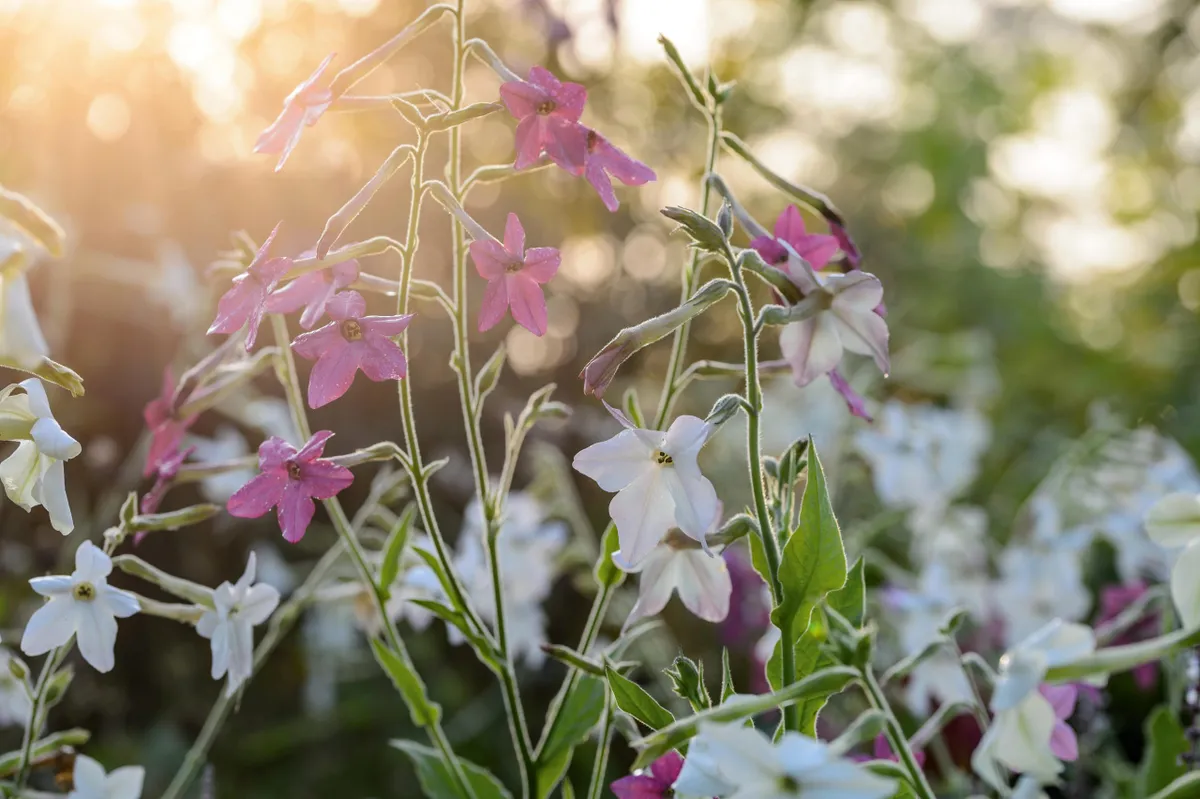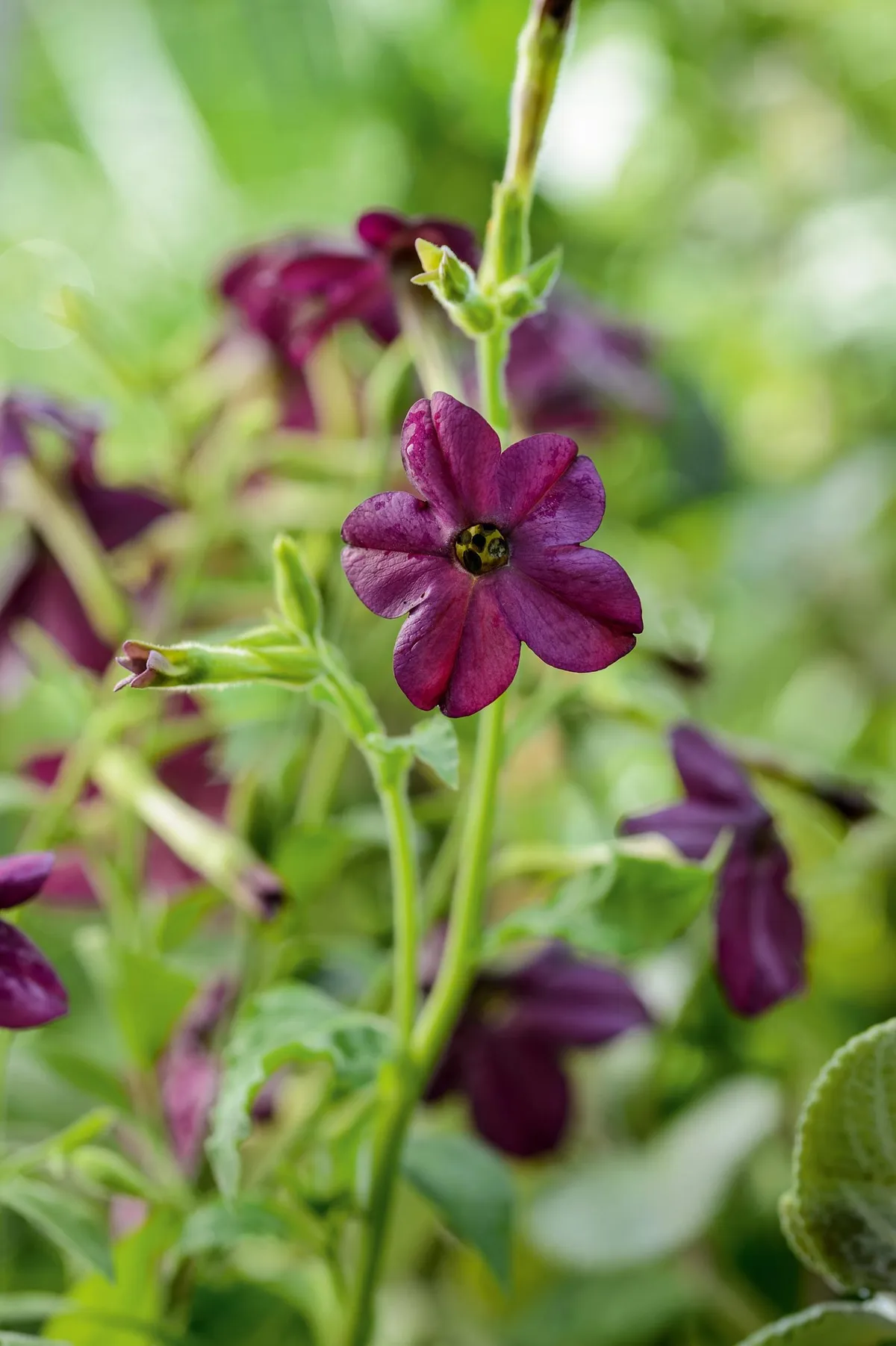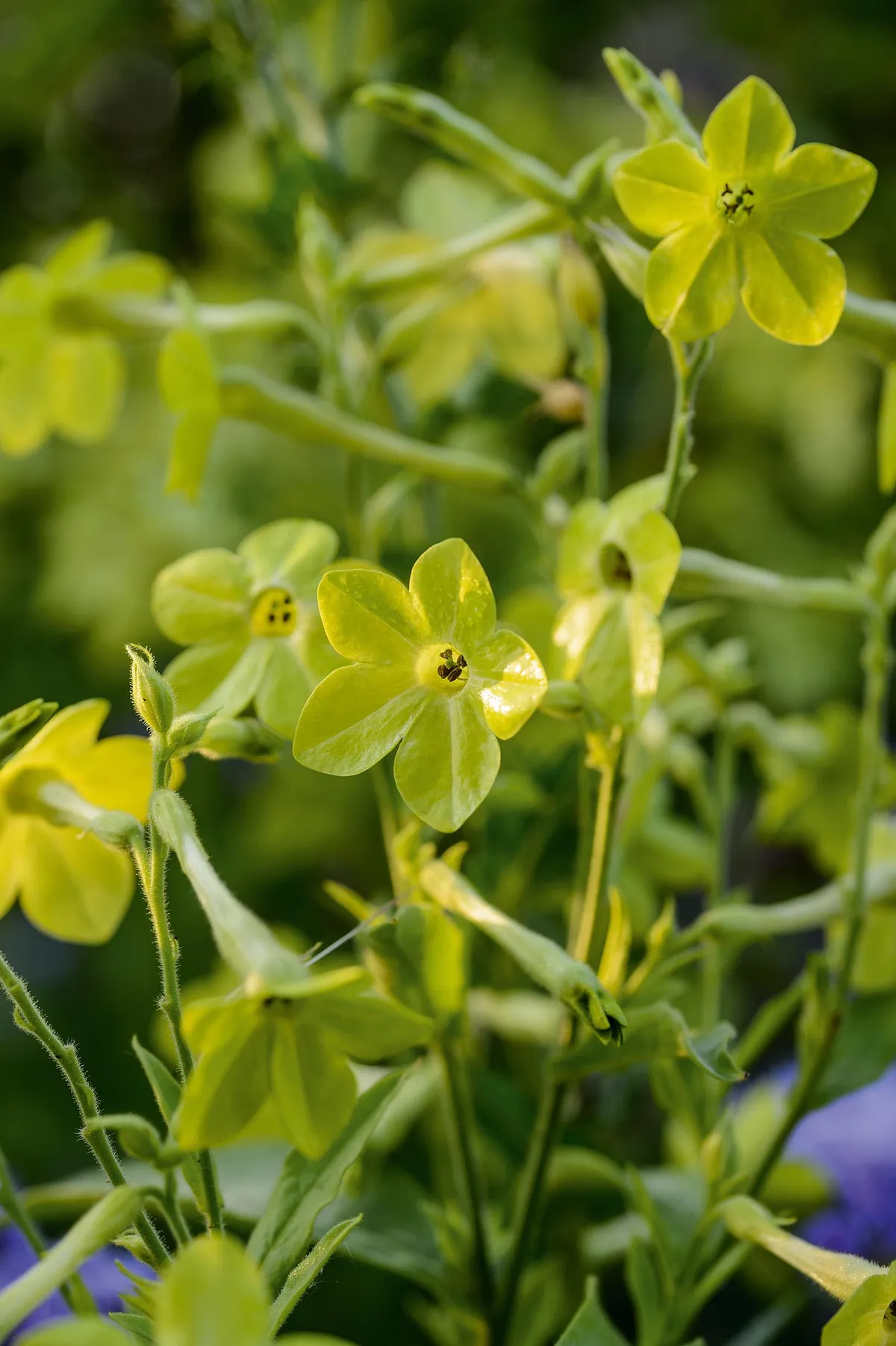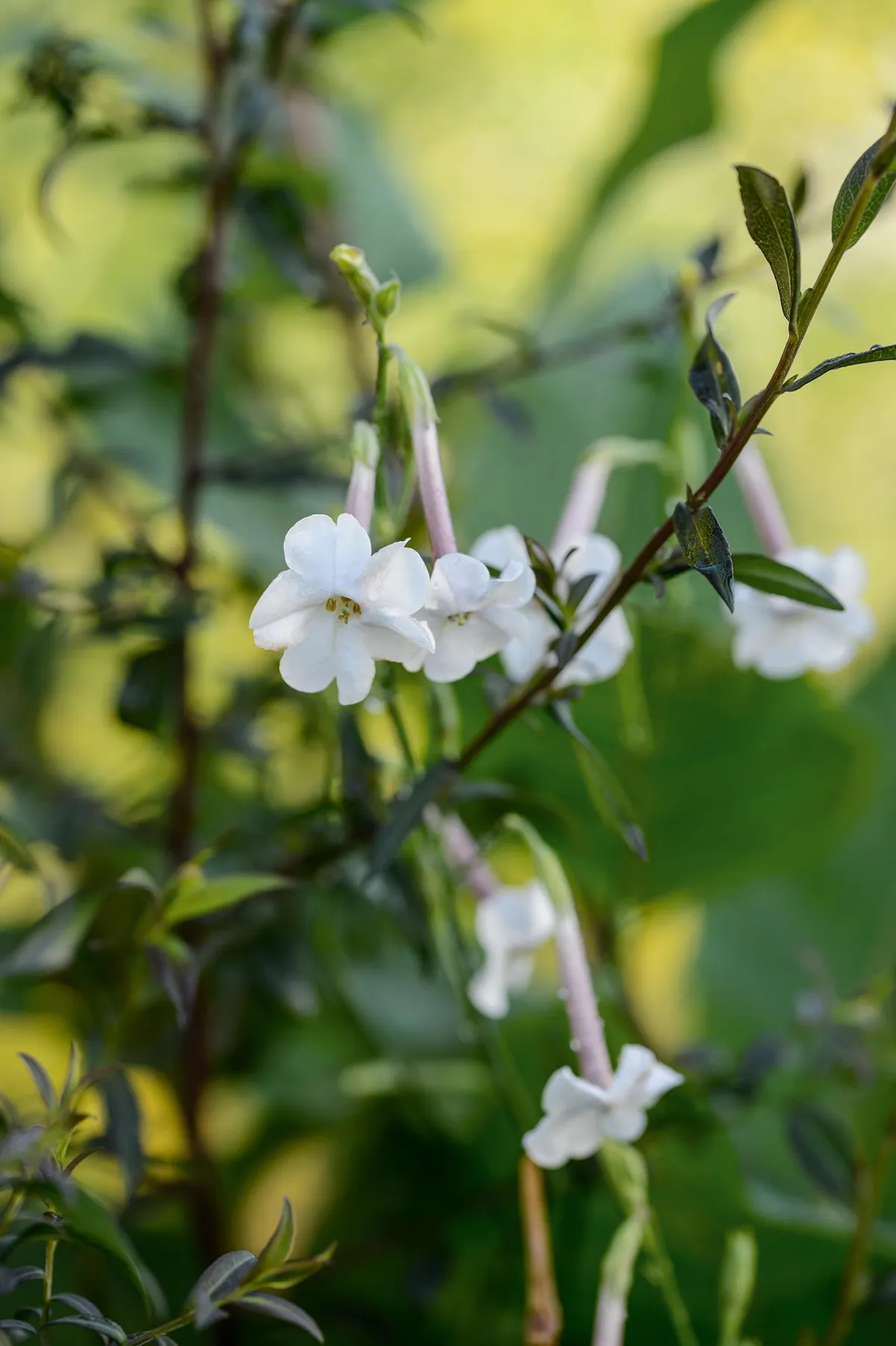Nicotiana is a genus of 67 species of half-hardy annuals, perennials, and a few woody plants, all of which are poisonous. Nicotiana tabacum is most widely grown commercially for tobacco production, but many other species have beautiful flowers and make excellent garden plants.
You may also like
Nicotiana is native of America (mostly the tropics), Pacific Islands, Namibia and Australia and the plants' season is summer into autumn. Although they may flower year-round when grown in a heated greenhouse.

The larger-flowered cultivars are very good for late summer bedding in mixed borders. The green-flowered cultivars, such as Nicotiana ‘Lime Green’, are excellent in combination with the clambering, magenta-flowered Petunia integrifolia (a close cousin of the tobaccos), or the powder-blue flowers of Ageratum houstonianum ‘Blue Horizon’. The more sizeable Nicotiana sylvestris is a wonderful, stately plant that can hold its own when partnered with other large, bold plants. In the Exotic Garden, at Great Dixter, it combined well with cannas and dahlias.
Jump to
- How tall do nicotiana grow?
- How to grow nicotiana
- When to plant nicotiana seeds
- When to plant out nicotiana
- Problems with nicotianas
- The best nicotiana to grow
How tall do nicotiana grow?
Nicotiana's can grow up to 1.5m and they are best grown as half-hardy annuals in a warm sunny position, and in moist and rich, free-draining soil.
How to grow nicotiana
Nicotianas are generally grown as half-hardy annuals in the UK. Most have a hardiness rating of RHS H2 and are suitable for gardens in USDA zones 9a to 11.

Growing nicotianas from seed
Growing nicotianas for the flower garden is a relatively easy affair. To get the most vigorous nicotiana plants, you should grow them annually from seed, although there are some species that are perennial. In warmer countries, or in a heated greenhouse, they can make comparatively large, long-lived plants. They can be propagated from cuttings or offsets, even self-sown seedlings weeded out from the gravel beneath greenhouse benches will regrow from any roots left behind.
When to plant nicotiana seeds
Seed should be sown thinly on to moist, light compost from February to March. The seed is generally quite fine, and should only be covered very lightly and kept under glass or indoors at around 18-20°C. Germination takes about a fortnight and is usually quite uniform. Seedlings should then be moved on individually into plugs or small pots as soon as they are large enough to handle. Make sure seedlings have been kept well-watered before transferring, this will help the small plants negotiate the stress of upheaval. It is also worth noting that tobaccos have brittle, clingy leaves that stick to one another and will rip or break if you don’t take due care while separating.
Nicotianas are hungry plants, so avoid letting them become pot-bound or starved as this will pinch their growth and give you small, spindly plants.

When to plant out nicotiana
Although tobaccos can tolerate mild frosts, it’s important to ensure a gentle transition from the heated greenhouse to the garden. Nicotiana plants should be hardened off in a cold frame before planting out in late May. Even with the onset of warmer days, do keep an eye on overnight temperatures as a cold night can shock the growth of these tender plants – it’s much better to delay planting until the danger has passed and hit the ground running.
Nicotianas will thrive in a deeply dug, light soil that has been improved with good compost. Water and feed as necessary through the summer.
Nicotianas have strong stems and require little staking, but in an exposed position or in windy weather the plants may rock at the base, in which case a short cane would be beneficial to support the plants.
Problems with nicotianas
Slugs and snails can be a nuisance for young plants and make untidy holes in the leaves, also be cautious of aphids and whitefly, which will colonise both the flowers and foliage.
Hot, dry weather can render nicotianas more susceptible to mildew and a fungicidal spray may be needed under these conditions.
The best nicotiana to grow
Nicotiana Evening Fragrance mix

A colourful seed strain with large, highly fragrant, pendent blooms. Flowers are produced prolifically through the summer in shades of pink, rose, red, lilac, mauve-purple and white. Flowers are at their nicest in the evening and scented from 6pm into the night. 90cm. RHS H2, USDA 9a-11.
Nicotiana ‘Tinkerbell’

A new and particularly interesting tobacco, which is a hybrid of Nicotiana langsdorffii, and has an open, branching habit with many bicoloured, tubular flowers arranged in drooping panicles. The blooms are chartreuse-green with red faces and green eyes. It makes an excellent cut flower. 1.2m. RHS H2, USDA 9a-11.
Nicotiana x sanderae ‘Cuba Deep Lime’

A vigorous, compact plant with large, apple-green flowers that are produced throughout summer and are scented in the evenings. Plant in free-draining soil or containers. Looks good with Salvia patens ‘Cambridge Blue’. 30cm. RHS H2, USDA 9a-11.
Nicotiana langsdorffii

This plant has a wonderful airy carriage with slender stems bearing masses of downward-facing, trumpet-shaped flowers in lime green. Conspicuous, dark-blue anthers protrude slightly from the centre of each flower. Nicotiana langsdorffii makes a wonderful companion for blue salvias or pink dahlias. 1.5m. AGM. RHS H2, USDA 9a-11.
Nicotiana ‘Babybella’

A new cultivar with large, dark-maroon flowers held on stiff flower spikes. Flowers all summer and makes a good pot plant and cut flower. Combines well with Ageratum houstonianum ‘Blue Horizon’ or Cerinthe major ‘Purpurascens’. 60cm. RHS H2, USDA 9a-11.
Nicotiana x sanderae ‘Perfume Deep Purple’

One of the Perfume Series bred for disease resistance, improved flowering and strong evening fragrance. The upward-facing, velvety purple flowers have contrasting yellow anthers and are produced all summer. 40cm. RHS H2, USDA 9a-11.
Nicotiana ‘Lime Green’

This cultivar has smaller, lime-green flowers on taller stems than the squatter Nicotiana ‘Cuba Deep Lime’, and also makes an excellent bedding plant. As with most green-flowered plants, it will consort with almost anything and is a long-lasting cut flower. 50cm. AGM. RHS H2, USDA 9a-11.
Nicotiana ‘Starlight Dancer’

A recent cross between Nicotiana langsdorffii and Nicotiana alata. Produces tall, branching stems with masses of green and white, bell-shaped flowers. Looks like a white Nicotiana langsdorffii and is a good see-through plant for weaving. 1m. RHS H2, USDA 9a-11.
Nicotiana sylvestris

Larger and more stately than other ornamental tobaccos, it has striking, paddle-shaped foliage held on strong, woody stems. Long, tubular, white flowers are scented and held in tight clusters that shoot outwards. Can self-seed and is nearly hardy. 1.5m. AGM. RHS H2, USDA 9a-11.
Nicotiana Whisper mix

A tall new hybrid with masses of star-shaped flowers similar to Nicotiana alata but with the colouring of its other parent Nicotiana mutabilis. Blossoms open in shades of soft pink and darken with age. Flowers continuously through summer until the first frosts. 90cm. RHS H2, USDA 9a-11.
Nicotiana x sanderae Eau de Cologne mixed

A short bedding mix that produces masses of upward-facing blooms in shades of red, pink, mauve, green and purple. Blooms resist closing during the day and are scented in the evening. Excellent for front of the border or pot. 50cm. RHS H2, USDA 9a-11.
Nicotiana suaveolens

A night-flowering species from Australia with nodding, dainty, tubular white flowers that have a very sweet evening fragrance. Can be grown as an annual or biennial. Particularly good for the conservatory, but equally at home in the garden. 80cm. RHS H2, USDA 9a-11.
Nicotiana x sanderae ‘Little Nicky’

A shorter seed strain with large, upward-facing flowers in shades of white, pink and red. The scented flowers look particularly good in combination with a silver foil, such as Plectranthus argentatus or Helichrysum petiolare. 30cm. RHS H2, USDA 9a-11.
Where to buy and see nicotiana
• Chiltern Seeds, Crowmarsh Battle, Barns, 114 Preston Crowmarsh, Wallingford, Oxfordshire OX10 6SL. Tel 01491 824675, chilternseeds.co.uk
• Plants of Distinction, Church Farm Cottage, The Street, nr Stowmarket, Suffolk IP14 6HG. Tel 01449 721720, plantsofdistinction.co.uk
• Special Plants, Special Plants, Greenways Lane, Cold Ashton, Chippenham, Wiltshire SN14 8LA. Tel 01225 891686, specialplants.net
• Great Dixter, Northiam, Rye, East Sussex TN31 6PH. Tel 01797 252878, greatdixter.co.uk
• Malverleys Gardens, East End, Hampshire RG20 0AA. malverleys.co.uk, open by appointment and usually for the NGS in April and July.
• Perch Hill Farm, Willingford Lane, Brightling, Robertsbridge, East Sussex TN32 5HP. Tel 01424 838000, sarahraven.com. Open by appointment and on select visiting days.
Author Matthew Reese is head gardener at Malverleys in Hampshire. Malverleys in Hampshire is one of the UK’s most impressive flower gardens with abundantly planted terraces and long borders that hold a rich mix of hard-working plants, including the Nicotiana species and cultivars featured here. malverleys.co.uk




